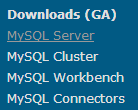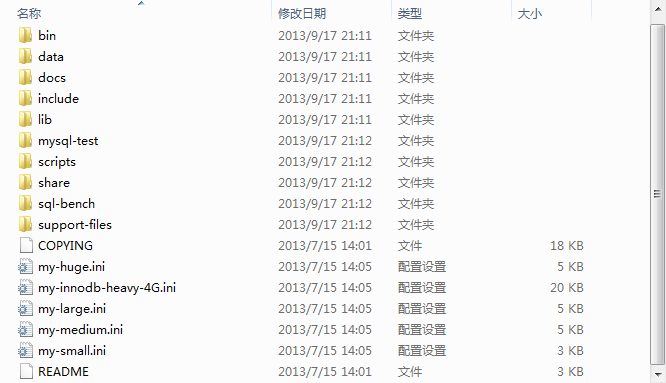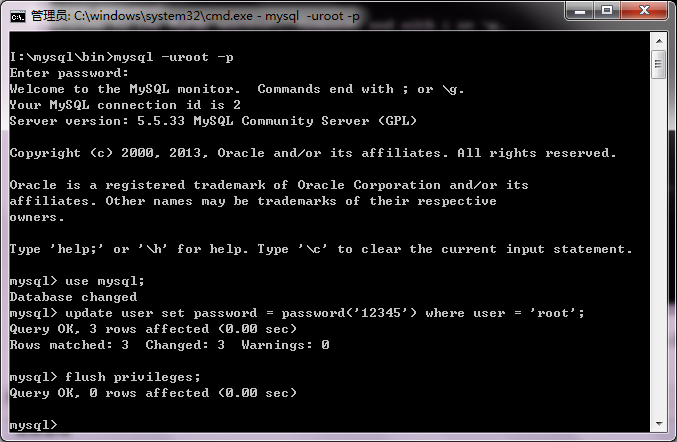Windows下MySQL的绿化与精简
MySQL本身就支持安装使用,本文只是对自己使用免安装版MySQL的经历记录下来,以便以后查看。
首先是获取Windows下的MySQL免安装版本,这个需要去到MySQL官网进行下载。我一般喜欢把首页页面拖动到最下方,点击MySQL Server进入下载。

我下载了MySQL5.5.33版本(zip包)。
得到的文件就是mysql-5.5.33-win32.zip,解压出来后我把名字改成了mysql。

我们保留文件夹bin、data和share,其余的文件夹可以删除。
还需要一个my.ini作为配置文件,zip包中的几个ini是根据你物理机硬件水平进行选择的,从<=64M到4G的内存。
我一般都直接删除,然后沿用以前的ini文件,你也可以选择适合自己的my-*.ini进行配置然后改名为my.ini。我使用的旧配置文件:

1 # MySQL Server Instance Configuration File 2 # ---------------------------------------------------------------------- 3 # Generated by the MySQL Server Instance Configuration Wizard 4 # 5 # 6 # Installation Instructions 7 # ---------------------------------------------------------------------- 8 # 9 # On Linux you can copy this file to /etc/my.cnf to set global options, 10 # mysql-data-dir/my.cnf to set server-specific options 11 # (@localstatedir@ for this installation) or to 12 # ~/.my.cnf to set user-specific options. 13 # 14 # On Windows you should keep this file in the installation directory 15 # of your server (e.g. C:\Program Files\MySQL\MySQL Server X.Y). To 16 # make sure the server reads the config file use the startup option 17 # "--defaults-file". 18 # 19 # To run run the server from the command line, execute this in a 20 # command line shell, e.g. 21 # mysqld --defaults-file="C:\Program Files\MySQL\MySQL Server X.Y\my.ini" 22 # 23 # To install the server as a Windows service manually, execute this in a 24 # command line shell, e.g. 25 # mysqld --install MySQLXY --defaults-file="C:\Program Files\MySQL\MySQL Server X.Y\my.ini" 26 # 27 # And then execute this in a command line shell to start the server, e.g. 28 # net start MySQLXY 29 # 30 # 31 # Guildlines for editing this file 32 # ---------------------------------------------------------------------- 33 # 34 # In this file, you can use all long options that the program supports. 35 # If you want to know the options a program supports, start the program 36 # with the "--help" option. 37 # 38 # More detailed information about the individual options can also be 39 # found in the manual. 40 # 41 # 42 # CLIENT SECTION 43 # ---------------------------------------------------------------------- 44 # 45 # The following options will be read by MySQL client applications. 46 # Note that only client applications shipped by MySQL are guaranteed 47 # to read this section. If you want your own MySQL client program to 48 # honor these values, you need to specify it as an option during the 49 # MySQL client library initialization. 50 # 51 [client] 52 53 port=3306 54 55 [mysql] 56 57 default-character-set=utf8 58 59 60 # SERVER SECTION 61 # ---------------------------------------------------------------------- 62 # 63 # The following options will be read by the MySQL Server. Make sure that 64 # you have installed the server correctly (see above) so it reads this 65 # file. 66 # 67 [mysqld] 68 69 # The TCP/IP Port the MySQL Server will listen on 70 port=3306 71 72 73 #Path to installation directory. All paths are usually resolved relative to this. 74 basedir="./mysql" 75 76 #Path to the database root 77 datadir="./mysql/data/" 78 79 # The default character set that will be used when a new schema or table is 80 # created and no character set is defined 81 character-set-server=utf8 82 83 # The default storage engine that will be used when create new tables when 84 default-storage-engine=INNODB 85 86 # Set the SQL mode to strict 87 sql-mode="STRICT_TRANS_TABLES,NO_AUTO_CREATE_USER,NO_ENGINE_SUBSTITUTION" 88 89 # The maximum amount of concurrent sessions the MySQL server will 90 # allow. One of these connections will be reserved for a user with 91 # SUPER privileges to allow the administrator to login even if the 92 # connection limit has been reached. 93 max_connections=100 94 95 # Query cache is used to cache SELECT results and later return them 96 # without actual executing the same query once again. Having the query 97 # cache enabled may result in significant speed improvements, if your 98 # have a lot of identical queries and rarely changing tables. See the 99 # "Qcache_lowmem_prunes" status variable to check if the current value 100 # is high enough for your load. 101 # Note: In case your tables change very often or if your queries are 102 # textually different every time, the query cache may result in a 103 # slowdown instead of a performance improvement. 104 query_cache_size=0 105 106 # The number of open tables for all threads. Increasing this value 107 # increases the number of file descriptors that mysqld requires. 108 # Therefore you have to make sure to set the amount of open files 109 # allowed to at least 4096 in the variable "open-files-limit" in 110 # section [mysqld_safe] 111 table_cache=256 112 113 # Maximum size for internal (in-memory) temporary tables. If a table 114 # grows larger than this value, it is automatically converted to disk 115 # based table This limitation is for a single table. There can be many 116 # of them. 117 tmp_table_size=35M 118 119 120 # How many threads we should keep in a cache for reuse. When a client 121 # disconnects, the client's threads are put in the cache if there aren't 122 # more than thread_cache_size threads from before. This greatly reduces 123 # the amount of thread creations needed if you have a lot of new 124 # connections. (Normally this doesn't give a notable performance 125 # improvement if you have a good thread implementation.) 126 thread_cache_size=8 127 128 #*** MyISAM Specific options 129 130 # The maximum size of the temporary file MySQL is allowed to use while 131 # recreating the index (during REPAIR, ALTER TABLE or LOAD DATA INFILE. 132 # If the file-size would be bigger than this, the index will be created 133 # through the key cache (which is slower). 134 myisam_max_sort_file_size=100G 135 136 # If the temporary file used for fast index creation would be bigger 137 # than using the key cache by the amount specified here, then prefer the 138 # key cache method. This is mainly used to force long character keys in 139 # large tables to use the slower key cache method to create the index. 140 myisam_sort_buffer_size=69M 141 142 # Size of the Key Buffer, used to cache index blocks for MyISAM tables. 143 # Do not set it larger than 30% of your available memory, as some memory 144 # is also required by the OS to cache rows. Even if you're not using 145 # MyISAM tables, you should still set it to 8-64M as it will also be 146 # used for internal temporary disk tables. 147 key_buffer_size=55M 148 149 # Size of the buffer used for doing full table scans of MyISAM tables. 150 # Allocated per thread, if a full scan is needed. 151 read_buffer_size=64K 152 read_rnd_buffer_size=256K 153 154 # This buffer is allocated when MySQL needs to rebuild the index in 155 # REPAIR, OPTIMZE, ALTER table statements as well as in LOAD DATA INFILE 156 # into an empty table. It is allocated per thread so be careful with 157 # large settings. 158 sort_buffer_size=256K 159 160 161 #*** INNODB Specific options *** 162 163 164 # Use this option if you have a MySQL server with InnoDB support enabled 165 # but you do not plan to use it. This will save memory and disk space 166 # and speed up some things. 167 #skip-innodb 168 169 # Additional memory pool that is used by InnoDB to store metadata 170 # information. If InnoDB requires more memory for this purpose it will 171 # start to allocate it from the OS. As this is fast enough on most 172 # recent operating systems, you normally do not need to change this 173 # value. SHOW INNODB STATUS will display the current amount used. 174 innodb_additional_mem_pool_size=3M 175 176 # If set to 1, InnoDB will flush (fsync) the transaction logs to the 177 # disk at each commit, which offers full ACID behavior. If you are 178 # willing to compromise this safety, and you are running small 179 # transactions, you may set this to 0 or 2 to reduce disk I/O to the 180 # logs. Value 0 means that the log is only written to the log file and 181 # the log file flushed to disk approximately once per second. Value 2 182 # means the log is written to the log file at each commit, but the log 183 # file is only flushed to disk approximately once per second. 184 innodb_flush_log_at_trx_commit=1 185 186 # The size of the buffer InnoDB uses for buffering log data. As soon as 187 # it is full, InnoDB will have to flush it to disk. As it is flushed 188 # once per second anyway, it does not make sense to have it very large 189 # (even with long transactions). 190 innodb_log_buffer_size=2M 191 192 # InnoDB, unlike MyISAM, uses a buffer pool to cache both indexes and 193 # row data. The bigger you set this the less disk I/O is needed to 194 # access data in tables. On a dedicated database server you may set this 195 # parameter up to 80% of the machine physical memory size. Do not set it 196 # too large, though, because competition of the physical memory may 197 # cause paging in the operating system. Note that on 32bit systems you 198 # might be limited to 2-3.5G of user level memory per process, so do not 199 # set it too high. 200 innodb_buffer_pool_size=107M 201 202 # Size of each log file in a log group. You should set the combined size 203 # of log files to about 25%-100% of your buffer pool size to avoid 204 # unneeded buffer pool flush activity on log file overwrite. However, 205 # note that a larger logfile size will increase the time needed for the 206 # recovery process. 207 innodb_log_file_size=54M 208 209 # Number of threads allowed inside the InnoDB kernel. The optimal value 210 # depends highly on the application, hardware as well as the OS 211 # scheduler properties. A too high value may lead to thread thrashing. 212 innodb_thread_concurrency=10
上文中basedir和datadir比较重要,从名称来看是指mysql的安装路径和数据文件存放路径,我已经修改了。
bin文件夹中的.pdb文件是没有存在感的,*test*.exe和*debug*.exe我也删除了。
最后的文件结构大概是这个样子:

COPYING是我特意留下的,你可以去除。
这个样子就算OK了,我们可以使用批处理指令启动MySQL了:
1 "./mysql/bin/mysqld.exe" --defaults-file=./mysql/my.ini
不过这个命令必须cd到mysql文件夹所在目录进行,或者是将上面的语句保存为*.bat(也要放到mysql同级目录下):

启动mysql.bat,mysql数据库就开始工作了。

这个窗口会卡住,但其实它是可以关闭的,关闭后mysql没有被结束:

我们登录进mysql:

mysql的初始密码是空,所以我们只需要在Enter password:后面敲击回车(不要做任何输入)即可进入系统。
我们先对root的密码进行设置:

然后删除匿名用户(匿名用户就是登录名为空的用户,它不需要密码即可登录,对安全性有影响)。当然,先删除匿名用户再改root密码也可以:

现在,mysql数据库就配置好了。
通过一个批处理命令和windows shell的结合,我们可以实现mysql只启动一次且不卡住窗口:
1 tasklist | find /i "mysqld.exe" 2 if %errorlevel%==0 (exit) else goto stm 3 :stm 4 start /min "" "./mysql/bin/mysqld.exe" --defaults-file=./mysql/my.ini
(值得一提的是我们并没有考虑将mysql作为系统服务,因为上文的路径是相对路径,理论上我们可以随意移动。而服务要求路径明确,不过服务的优势在于比较方便地跟随系统启动和关闭,容易挂起等)
最后介绍一个我的思路,我通常会为一个项目维护一个数据库,而且使用一个专门的用户来进行管理。
比如我会使用如下语句来创建用户:
1 grant all privileges on testdb.* to testuser identified by 'testuser';
上述语句可以在testdb还未创建时执行,而且testdb被删除重建后testeuser仍然具有权限。
不过上述语句没有赋予testuser创建视图的权利,所以我建议大家使用root完成视图的创建。
(最后编辑时间2013-09-17 21:57:02)





